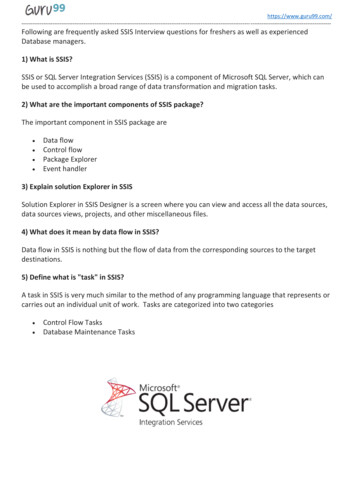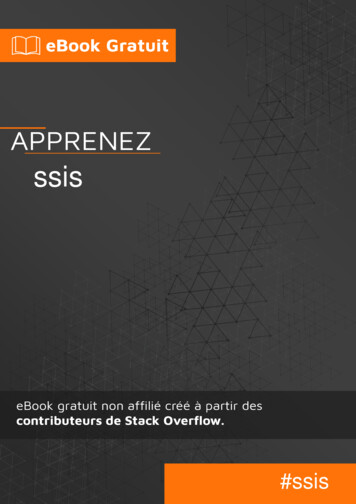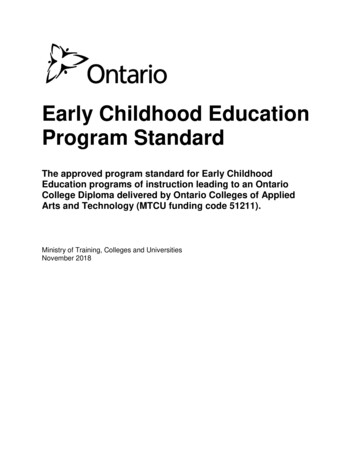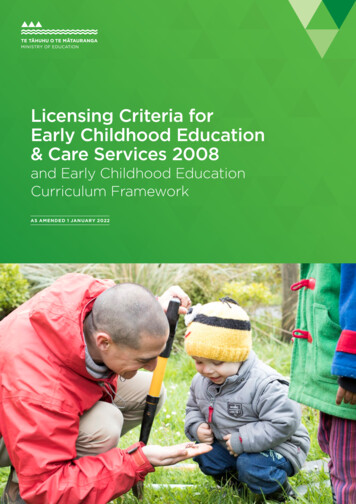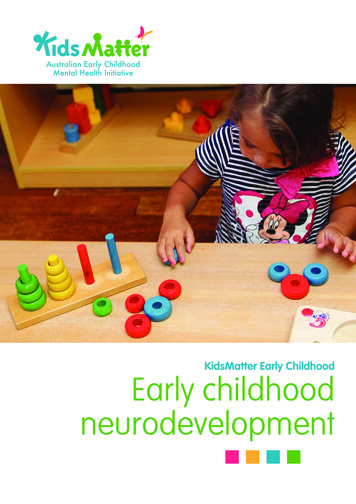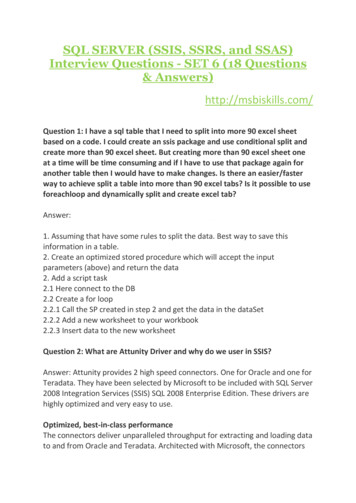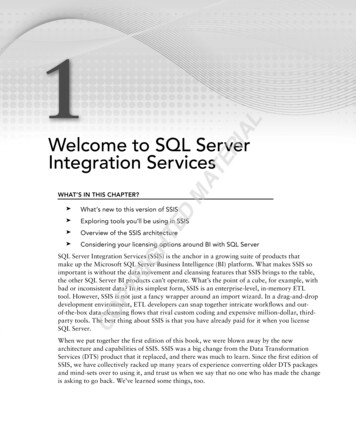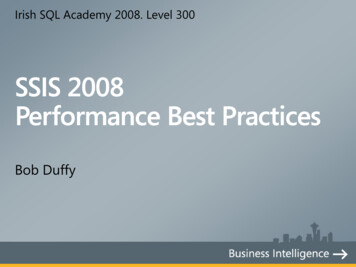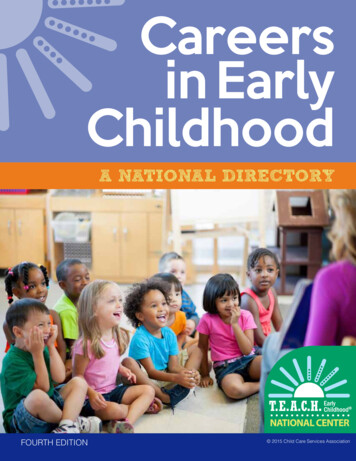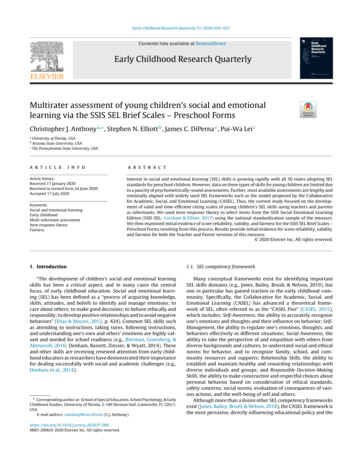
Transcription
Early Childhood Research Quarterly 53 (2020) 625–637Contents lists available at ScienceDirectEarly Childhood Research QuarterlyMultirater assessment of young children’s social and emotionallearning via the SSIS SEL Brief Scales – Preschool FormsChristopher J. Anthony a, , Stephen N. Elliott b , James C. DiPerna c , Pui-Wa Lei cabcUniversity of Florida, USAArizona State University, USAThe Pennsylvania State University, USAa r t i c l ei n f oArticle history:Received 17 January 2020Received in revised form 24 June 2020Accepted 17 July 2020Keywords:Social and emotional learningEarly childhoodMulti-informant assessmentItem response theoryFairnessa b s t r a c tInterest in social and emotional learning (SEL) skills is growing rapidly with all 50 states adopting SELstandards for preschool children. However, data on these types of skills for young children are limited dueto a paucity of psychometrically-sound assessments. Further, most available assessments are lengthy andminimally aligned with widely used SEL frameworks such as the model proposed by the Collaborativefor Academic, Social, and Emotional Learning (CASEL). Thus, the current study focused on the development of valid and time-efficient rating scales of young children’s SEL skills using teachers and parentsas informants. We used item response theory to select items from the SSIS Social Emotional LearningEdition (SSIS SEL; Gresham & Elliott, 2017) using the national standardization sample of the measure.We then examined initial evidence of score reliability, validity, and fairness for the SSIS SEL Brief Scales –Preschool Forms resulting from this process. Results provide initial evidence for score reliability, validity,and fairness for both the Teacher and Parent versions of this measure. 2020 Elsevier Inc. All rights reserved.1. Introduction1.1. SEL competency framework“The development of children’s social and emotional learningskills has been a critical aspect, and in many cases the centralfocus, of early childhood education. Social and emotional learning (SEL) has been defined as a “process of acquiring knowledge,skills, attitudes, and beliefs to identify and manage emotions; tocare about others; to make good decisions; to behave ethically andresponsibly; to develop positive relationships and to avoid negativebehaviors” (Elias & Moceri, 2012, p. 424). Common SEL skills suchas attending to instructions, taking turns, following instructions,and understanding one’s own and others’ emotions are highly valued and needed for school readiness (e.g., Bierman, Greenberg, &Abenavoli, 2016; Denham, Bassett, Zinsser, & Wyatt, 2014). Theseand other skills are receiving renewed attention from early childhood educators as researchers have demonstrated their importancefor dealing successfully with social and academic challenges (e.g.,Denham et al., 2014).Many conceptual frameworks exist for identifying importantSEL skills domains (e.g., Jones, Bailey, Brush, & Nelson, 2019), butone in particular has gained traction in the early childhood community. Specifically, the Collaborative for Academic, Social, andEmotional Learning (CASEL) has advanced a theoretical framework of SEL, often referred to as the “CASEL Five” (CASEL, 2015),which includes: Self-Awareness, the ability to accurately recognizeone’s emotions and thoughts and their influence on behavior; SelfManagement, the ability to regulate one’s emotions, thoughts, andbehaviors effectively in different situations; Social Awareness, theability to take the perspective of and empathize with others fromdiverse backgrounds and cultures, to understand social and ethicalnorms for behavior, and to recognize family, school, and community resources and supports; Relationship Skills, the ability toestablish and maintain healthy and rewarding relationships withdiverse individuals and groups; and Responsible Decision-MakingSkills, the ability to make constructive and respectful choices aboutpersonal behavior based on consideration of ethical standards,safety concerns, social norms, evaluation of consequences of various actions, and the well-being of self and others.Although more than a dozen other SEL competency frameworksexist (Jones, Bailey, Brush, & Nelson, 2018), the CASEL framework isthe most pervasive, directly influencing educational policy and the Corresponding author at: School of Special Education, School Psychology, & EarlyChildhood Studies, University of Florida, 2-189 Norman Hall, Gainesville, FL 32611,USA.E-mail address: canthony@coe.ufl.edu (C.J. 0060885-2006/ 2020 Elsevier Inc. All rights reserved.
626C.J. Anthony et al. / Early Childhood Research Quarterly 53 (2020) 625–637development of dozens of school-based intervention programs inthe United States, England, New Zealand, and Australia. For example, an examination of the CASEL State Scan report (Dusenbury,Dermody, & Weissberg, 2018) documented that all 50 states, alongwith the District of Columbia and five U.S. territories, have identified Pre-K competencies/standards for SEL. Furthermore, most ofthese state standards align very closely, if not completely, withthe CASEL framework. Specifically, in a study evaluating the content alignment of Pre-K state standards with the CASEL framework,Eklund, Kilpatrick, Kilgus, and Haider (2018) concluded that 34states and the District of Columbia included all five CASEL domains,14 states identified four of the CASEL domains, and the remainingstates included three. Based on their review, Eklund et al. concludedthat the CASEL framework could serve a unifying function for promoting SEL-focused service provision similar to the function thatthe “Big Five” reading competencies of the National Reading Panel(2000) served for reading assessment and instruction.1.2. Assessment of early childhood SEL competencies and skillsTo promote attention to children’s SEL skills and development,several direct measures of SEL-related constructs have been developed and refined over the past few decades. Indeed, Denham et al.(2014) found that scores from several of these direct measures werepredictive of later school readiness, which led these authors to promote their broad use in preschool assessment. Direct measureshave important advantages for assessment, especially for internalized constructs (McKown, 2017). For example, McKown noted,“although observers and raters can make educated guesses aboutchildren’s thinking skills, these skills exist in a child’s mind andcan’t be directly observed” (pp. 168–169). For these and similarconstructs (e.g., self-awareness) it can be very difficult for external observers to infer children’s skill levels. As such, there is animportant role for direct assessment in preschool SEL practiceand much research has focused on developing and honing thesetools.Yet, direct assessments also have important limitations. Forexample, Denham et al. (2014) concluded that traditional useof direct assessment is “time prohibitive” (p. 447) a concernechoed by others (e.g., McKown, 2017). Another assessmentmodality – rating scales – have distinct advantages in thisdomain and are considered optimal for assessing behavioralexpression of SEL skills (McKown, 2017). Although the CASELframework has influenced policy and practice, there are surprisingly few sound rating scales of preschool children’s SELskills. For example, the CASEL Assessment Guide (https://measuringsel.casel.org/assessment-guide/) and RAND AssessmentFinder /tool),two major online compendia dedicated to documenting assessments of SEL competencies, collectively list over 50 assessmentsof children and youth SEL skills, but only four rating scale assessments of preschool children’s SEL skills (Table 1). In addition,searches of other comprehensive test resources (e.g., Tests in PrintIX; Anderson, Schlueter, Carlson, & Geisinger, 2016) did not yieldany additional published preschool SEL rating scales.Two of the four preschool rating scales are from the SSIS SELEdition of assessments including the SSIS SEL Rating Form-Teacherand Parent versions (Gresham & Elliott, 2017) and SSIS SEL Screening and Progress Monitoring Scales (Elliott & Gresham, 2017a). TheScreening and Progress Monitoring Scales are criterion-referencedperformance rubrics designed to be used with the SSIS SEL Classwide Intervention Program (Elliott & Gresham, 2017b). The SSISSEL Rating Forms are norm-referenced measures, available in bothEnglish and Spanish, and allow for a multi-informant (teacher andparent) examination of young children’s SEL strengths and areas forimprovement. Both the Teacher and Parent versions of SSIS SEL arecomprised of 51 items, each of which is aligned with a competencydomain in the CASEL framework.One major advantage of the SSIS SEL Rating Forms is theirprominence. The SSIS SEL is a successor to the Social Skills Rating System (SSRS; Gresham & Elliott, 1990), which is arguablythe most widely used measure of social competence in preschoolchildren. For example, in a review of over 75 measures of socialand emotional development of young (birth through age 5) children, Halle and Darling-Churchill (2016) concluded that only two,the Deveraux Early Childhood Assessment Clinical Form and theSSRS “combine a broad coverage of the subdomains of socialand emotional development with strong psychometric propertiesand ease of administration” (p. 15). It is perhaps due to theseadvantages that the SSRS and its successor assessments havebeen so prominent. For example, 14 items from the SSRS havebeen used for more than a decade by the Department of Education for their widely used Early Childhood Longitudinal Studies(Tourangeau, Nord, Lê, Pollack, & Atkins-Burnett, 2006; Tourangeauet al., 2019) and the SSRS is frequently used in practice (e.g.,Wang, Sandall, Davis, & Thomas, 2011). Thus, one advantage ofthe SSIS SEL forms is their prominence in both research and practice.Another important advantage of the SSIS family of assessmentsis their link with intervention programs with evidence of efficacy(e.g., DiPerna, Lei, Cheng, Hart, & Bellinger, 2018) and social validity(Wollersheim Shervey, Sandilos, DiPerna, & Lei, 2017). Specifically,results from SSIS SEL assessments provide a direct actionable link tothe SSIS SEL CIP (Elliott & Gresham, 2017), a teacher implemented,evidenced-based program for Pre-K to High School students. TheCIP focuses on skills that are assessed by the teachers and parentsvia the SSIS SEL Rating Forms (e.g., Listen to others, Follow the rules,Ask for help, Get along with others, Stay calm with others). These coreskills are fundamental to the development of healthy children andrecognized as salient during the 3–6 year old development period(Bierman & Motamedi, 2015). As such, the alignment between theSSIS SEL family of assessments and validated interventions presentanother key advantage.Despite these important advantages, there are limitations of theSSIS SEL and similar instruments. Most notably, although standardrating scales such as the SSIS SEL are generally more time-efficientthan direct measures, they are often still long, and the SSIS SEL isno exception. Specifically, the SSIS SEL is composed of 51 items andtakes teachers and parents roughly 15–20 min to complete. Thislimitation has been noted for assessments similar to the SSIS SEL,including the SSRS (e.g., Halle & Darling-Churchill, 2016). The lengthof the SSIS SEL is likely especially problematic for applications otherthan individual decision making. Yet, there are growing calls forbroad inclusion of strengths-based preschool assessment to bothidentify students in need and provide information to inform further assessment and intervention (e.g., Denham et al., 2014; LeBuffe& Shapiro, 2004). Assessment with teacher rating scales such asthe SSIS SEL for more than a few students at a time could quicklyoverburden teachers whose time is already limited. If conductedat the universal level, current measures are likely to be impractical for the vast majority of users – researchers and educatorsalike. For example, completion of SSIS SEL forms for 10–15 students could easily take 2–4 h of teacher time. Furthermore, long,extensive forms are likely a deterrent for parental completion offorms, limiting the sources from which information regarding student SEL can be gathered. As such, briefer versions of the SSIS SELappropriate for preschool children might serve to capitalize on thestrengths of the measure (CASEL alignment, prominence, alignment with intervention) while addressing its most critical currentlimitation.
C.J. Anthony et al. / Early Childhood Research Quarterly 53 (2020) 625–637627Table 1Description of published SEL assessments for preschool students.Assessment (publicationdate)Informant(s)# of itemsCompetencies assessedCompletion timePanorama SEL TeacherRating of Student SELCompetencies (2017)Teacher10–62 depending on grade10–15 minSix Seconds PerspectiveYouth Version (2018)Teacher Family51SSIS SEL Edition Screening& Progress MonitoringScales (2017)Teacher8 5-level performancerubricsSSIS SEL Edition RatingForms (2017)Teacher Parent51 SEL 7 AcademicCompetenceaClassroom Effort, Emotion Regulation,Grit, Growth Mindset, LearningStrategies, Self-Efficacy,Self-Management, Social PerspectiveTaking, Social Awareness37 competencies includingAdaptability, Consequential Thinking,Collaboration, Drive, Emotional Insight,Engage Intrinsic Motivation, Optimism,Focus, Good Health, Imagination,Empathy, Personal Achievement,Problem Solving, Resilience,Self-Awareness, Self-ManagementSelf-Awareness, Self-Management,Social Awareness, Relationship Skills,Responsible Decision Making;Motivation to Learn, Early Reading,Early MathematicsSelf-Awareness, Self-Management,Social Awareness, Relationship Skills,Responsible Decision Making;Academic Competencea5–10 min2 mins per student;35–40 min per class10–15 minNote. All assessments can be used with preschool – 12th grade students.aAcademic competence items of SSIS SEL Edition Rating Form are only included in the teacher form of the measure.1.3. Item response theory and the development of efficientassessmentsIn recent years, the need for efficient assessments of children’ssocial, emotional, and behavioral competencies has been raisedin other fields and with older student age groups (e.g., Anthony,DiPerna, & Lei, 2016; Anthony et al., 2020; Gresham et al., 2010).Indeed, several investigations have utilized advanced psychometric procedures to identify sets of items from full-length forms forthis very purpose (e.g., Anthony & DiPerna, 2017, 2018; Moulton,von der Embse, Kilgus, & Drymond, 2019). Such investigationshave increasingly relied on item response theory (IRT) to achievethese goals. Put briefly, IRT is a psychometric approach centeredon modeling the relationship between the latent construct beingmeasured (e.g., self-management) and one or more features of eachitem (e.g., the item’s difficulty). Scale development grounded in IRThas several advantages relative to traditional approaches groundedin classical test theory (CTT) including sample free estimation ofitem parameters (provided adequate model fit and satisfaction ofmodel assumptions), the ability to test the plausibility of alternatemeasurement models and the production of visual output demonstrating item function along the latent trait continuum (Anthonyet al., 2016). Perhaps most relevant for the process of improvingmeasurement efficiency, however, is the production of item andtest information functions.In IRT, the term information refers to score precision and is akinto reliability in CTT. Unlike CTT, however, information is not a staticfeature of tests in IRT, but rather varies across the latent constructbeing assessed (e.g., self-management). This feature of IRT allowstest developers to identify which items contribute the most to precision at which point on the latent construct scale. For example,using information functions, test developers can select items withhigh information in the “at risk” trait range for the purposes of educational screening. Such use of IRT allows for the selection of itemswhich are most efficient and thereby drastically shorten test lengthwhile retaining much of the precision of their parent forms, especially in the most important ranges of targeted latent traits (e.g.,lower ends of trait continua characterizing students at risk for persistent difficulty). This feature of IRT is especially helpful for thedevelopment of efficient forms of longer measures (Anthony et al.,2016).1There are also important advantages of IRT for evaluating andpromoting the fair and unbiased use of assessments. Specifically,IRT enables a fine-grained evaluation of Differential Item Functioning (DIF; Meade, 2010; Tay, Meade, & Cao, 2015). Succinctly, DIFoccurs when item functions (e.g., difficulties) differ across variousdemographic groups when holding latent trait level constant. Thus,mere mean differences on item scores do not necessarily indicateDIF. For example, an item in which girls who had the same overall self-management skills as boys scored substantially lower thanboys not attributable to chance error would likely be flagged forsex-based DIF. By itself, DIF does not necessarily indicate bias, butit always warrants careful attention and consideration. Fortunately,IRT enables fine grained evaluation of DIF including the consideration of effect sizes for the magnitude of DIF and the productionof indices and plots to determine the construct levels likely to beinfluenced by retention of DIF items.21.4. Purpose and research questionsAlthough brief versions of K-12 SEL rating scales recently havebeen developed (Anthony et al., 2020), no similar measures havebeen developed for use with preschoolers. Thus, in the remainderof this article, we report on the application of IRT to refine the SSISSEL Rating Forms into the more efficient SSIS SEL Brief Scales –Teacher Preschool Form (SSIS SELb–TP) and SSIS SEL Brief Scales –Parent Preschool Form (SSIS SELb-PP). In creating the SSIS SELb-TPand SSIS SELb-PP, we aimed to: (a) significantly reduce the lengthof the full length SSIS SEL assessments, (b) retain appropriate content coverage of SSIS SEL constructs, (c) produce scales yieldingscores with sufficient reliability for low stakes decisions, (d) pro-1For further reference on IRT in general, we recommend De Ayala (2013), orEmbretson and Reise (2000). For further reference on the use of IRT to developefficient versions of longer measures, we recommend Anthony et al. (2016).2For further reference on DIF, we recommend De Ayala (2013), Meade (2010),and Tay et al. (2015).
628C.J. Anthony et al. / Early Childhood Research Quarterly 53 (2020) 625–637Table 2Demographic characteristics of participants (percentages).students characteristicSSIS SELb-TP ( N 341)SSIS SELb-PP ( N 723)Current U.S. preschool ortheastMidwestSouthWestParent’s education levelGrade 11 or lessGrade 12 or GED1–3 years of college4 years of collegeEducational statusGeneral educationSpecial Note. Some percentages do not sum to 100 due to rounding. SSIS SELb-TP SSIS SEL Brief Scales – Teacher Preschool Form; SSIS SELb-PP SSIS SEL Brief Scales – ParentPreschool Form. Preschool population estimates from the 2018 Digest of Educational Statistics (Snyder, de Brey, & Dillow, 2019), which does not report data for Region orEducational Status.duce scales yielding scores with initial evidence of validity, and (e)generate scales with evidence indicating a lack of item and test bias.2. Method2.1. ParticipantsParticipants were teachers and parents of all 3- to 5-year-oldpreschool students collected for the SSIS standardization sample.Although the standardization sample included 200 cases rated byteachers and 400 cases rated by parents, additional cases were collected such that cases could be carefully selected to match censuspopulation estimates (i.e., in the initial standardization data collection, more cases than were needed for standardization werecollected). Because our planned IRT analyses function best withlarge sample sizes (De Ayala, 2013), we utilized all available cases(i.e., those included in the standardization sample as well as additional cases collected at the same time but not ultimately chosenfor the standardization sample). These additional cases renderedthe total number of cases 341 for the SSIS SEL – Teacher (SSIS SELT; Gresham & Elliott, 2017) and 723 for the SSIS SEL – Parent (SSISSEL-P; Gresham & Elliott, 2017). These cases were diverse acrossrace/ethnicity, sex, and parent education level. Full demographicdata for these cases are reported in Table 2.2.2. MeasuresSSIS Social Emotional Learning Edition Rating Form –Teacher. The SSIS SEL-T (Gresham & Elliott, 2017) is a nationallynormed behavior rating scales of SEL for students ages 3–18. TheSSIS SEL-T includes 58 items rated on a 4-point Likert scale from0 (Never) to 3 (Almost Always); 51 items measure SEL skills. Theremaining 7 items focus on academic competence and are not completed at the preschool level. With regard to reliability, coefficient ’s for students ages 3–5 ranged from .77 to .97, with a medianvalue of .90 across the five SSIS SEL scales and the SEL composite.Furthermore, 2-month stability coefficients for a sample of studentswere in the low .80s; mean scores between administrations werevery similar, with most effect sizes under .10. Although multiplesources of evidence are reported in the technical manual to supportthe validity of SSIS SEL-T scores for students ages 3–18, evidence for3–5 year olds was not examined separately. Finally, confirmatoryfactor analyses (CFA) also provided support for the internal struc-ture of the SSIS SEL-T yielding a six-factor model, five of whichrepresented the CASEL SEL competencies and a sixth factor representing Academic Competence (Gresham, Elliott, Byrd, Wilson, &Cassidy, 2018; Gresham et al., 2018b).SSIS Social Emotional Learning Edition Rating Form – Parent.The SSIS SEL-P (Gresham & Elliott, 2017) is a nationally normedbehavior rating scales of SEL for students ages 3–18. The SSIS SEL-Pincludes 51 items rated on a 4-point Likert scale from 0 (Never) to 3(Almost Always); these are the same 51 items measured on the SSISSEL teacher version and are rated on the same Likert scale. Withregard to reliability, coefficient ’s for students ages 3–5 rangedfrom .75 to .96, with a median value of .88 across the five SSIS SEL-Pscales and the SEL composite. Furthermore, 2-month stability coefficients for SEL subscales were in the upper .70s and low .80s; meanscores between administrations were very similar, with most effectsizes under .10, indicating very stable performance across the testing interval. Substantial evidence is reported to support the validityof SSIS SEL-P scores for samples of students ages 3–18, but subsample evidence for 3–5 year olds is not provided separately. Finally,CFAs also provided support of the internal structure of the SSISSEL-P yielding a five-factor model consistent with the CASEL SELcompetencies (Gresham, Elliott, Metallo, et al., 2018).Social Skills Rating System Teacher and Parent Forms. Thepreschool version of the SSRS (Gresham & Elliott, 1990) were usedas validity measures in this study. The Social Skills Scale of thepreschool SSRS-Teacher (SSRS-T) is comprised of three subscales:Cooperation, Assertion, and Self-Control. The SSRS-Parent (SSRSP) includes a fourth subscale of Responsibility. Using a 3-pointresponse scale, parents and teachers rate each social skills itembased on the frequency of the behavior. Response options includeNever, Sometimes, or Very Often. The Problem Behaviors Scale consists of Externalizing and Internalizing behavior subscales. TheProblem Behaviors Scale was intended to function as a screener,focusing on only 10 problem behavior items. Parents and teachersrate the frequency of each behavior as Never, Sometimes, or VeryOften. A sample (N 200) of preschool children primarily from twolarge metropolitan areas, one in the Southeastern and the other inthe Midwestern United States, was used to evaluate the psychometric characteristics of the preschool SSRS-T and SSRS-P.Evidence for the internal structure of the preschool SSRS wasestablished when the factor analysis of the scales conformed to thatfound with a much larger, nationally representative elementarysample (Gresham & Elliott, 1990). Subsequent scale and subscale
C.J. Anthony et al. / Early Childhood Research Quarterly 53 (2020) 625–637inter-correlations and item-total correlations also provided evidence the preschool scales psychometrically were functioning verysimilarly to the elementary version of scales based on a nearly identical pool of items (e.g., Frey, Elliott, & Gresham, 2011). Specifically,the SSRS-T Preschool version has high internal consistency for thetotal score ( .93) and test-retest reliability of .85. The SSRS-P version has high internal consistency for the total score ( .90) andtest–retest reliability of .87. Gresham and Elliott (1990) reportedthat each of the three prosocial skills scales on the SSRS-T and SSRSP correlated at a moderate negative level with the Walker ProblemBehavior Identification Checklist. Gresham, Elliott, and Black (1987)showed that the SSRS-T ratings on all factors were free from raterracial bias and sex bias.2.3. ProceduresData used in the current study were collected as part of the original SSIS Rating Scale standardization. Pearson Assessment fieldstaff recruited site coordinators in 21 schools across 15 states, whoin turn, recruited participants to fit demographic targets. Thesesite coordinators and their preschools distributed and collectedthe rating scales from September 2006 to October 2007. The finalstandardization sample was selected using a stratified randomsampling approach from the larger respondent sample to fit 2006U.S. Census demographics of age, sex, race/ethnicity, and educational status.2.4. Data analysesData analyses proceeded in several phases, including checkingIRT assumptions, item analysis, initial reliability analyses, and initial validity analyses. We first evaluated standard IRT assumptions,including the assumption of unidimensionality and local independence. First, standard IRT analyses assume that the targeted latentconstruct accounts for the majority of variance in items scores(i.e., that the item set is essentially unidimensional; Anthony et al.,2016). We evaluated unidimensionality by SSIS SEL scale usingexploratory factor analysis (EFA) conducted in MPlus (Muthen &Muthen, 2017). In line with recommendations for item level analyses for polytomous data with 4 or fewer categories (Rhemtulla,Brosseau-Liard, & Savalei, 2012), we treated item level data as categorical. We considered scales to be essentially unidimensionalif the ratio of the first to second eigenvalues exceeded 4 (Reeve,Hays, Chang, & Perfetto, 2007). In cases in which this threshold wasnot met, the lowest loading item was eliminated from consideration until all scales met this assumption. Next, IRT assumes that,controlling for the latent construct, items are not overly related.Violations of local independence could occur if, for example, itemswere redundant among other reasons (e.g., items such as “saysplease” and “says thank you”; Anthony et al., 2016). With regardto the assumption of local independence, we utilized standardizedlocal dependence 2 indices produced by IRTPro (Cai, Thissen, & duToit, 2019). When item pairs evidence local dependence (evaluatedwith a threshold of 10 as recommended by Cai et al., 2019), one ofthe items was excluded from further consideration such that theSSIS SELb forms had no items with evidence of local dependence.Once these assumptions had been checked, we conducted IRTanalyses. In line with similar investigations (e.g., Anthony et al.,2016; Moulton et al., 2019), we employed the Graded ResponseModel (GRM; Samejima, 1969) using IRTPro version 4 (Cai et al.,2019). We evaluated model fit with primary reference to RMSEA,with values less than .10 indicating adequate fit to the GRM(MacCallum, Browne, & Sugawara, 1996). We then utilized the iteminformation functions (IIFs) resulting from GRM analyses as the primary psychometric indicator of item adequacy when completingitem analysis. Our major goal in this process was to select items629that resulted in limited information loss overall and kept information above the .80 reliability threshold recommended for individualscreening decisions (Salvia, Ysseldyke, & Witmer, 2016). This reliability threshold corresponded with an information level of 5 basedon a formula demonstrated by Petrillo, Cano, McLeod, and Coon(2015) that converts IRT information into a standard reliability metric. In anticipation of probable use of the SSIS SELb with studentsexperiencing some difficulty, we specifically focused on the “at risk”range, which we defined as from .5 to 1.5 standard deviations belowthe mean (i.e., 0.5 to 1.5 on the scale).In addition to item information, we considered several otherindications of item quality when selecting items for the SSIS SELbforms. First, we considered item content to attempt to ensure aclose alignment between the SSIS SELb scales and corresponding CASEL domains. Furthermore, we evaluated items relative tothe preschool developmental behavioral expressions that wouldreflect CASEL competencies. Indeed, as a result of consideration ofthe content of the SSIS SEL Self Awareness scales relative to thedevelopmental level of preschool children, we opted to not selectitems for a brief Self-Awareness scale due to questions regardingthe developmental appropriateness of the items on the SSIS SEL forpreschool-age children. This challenge is not unique to the SSIS SELas self-awareness and other similar domains are very difficult forthird parties to assess in young children.
et al., 2019) and the SSRS is frequently used in practice (e.g., Wang, Sandall, Davis, & Thomas, 2011). Thus, one advantage of the SSIS SEL forms is their prominence in both research and prac-tice. Another important advantage of the SSIS family of assessments is their link with intervention programs with evidence of efficacy
